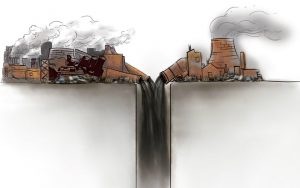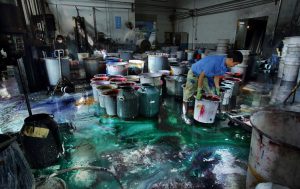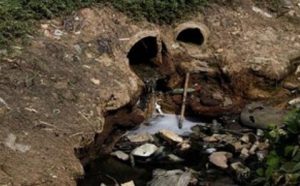This article won the prize for ´Best Scoop’ at the 2014 China Environmental Press Awards, jointly organised by chinadialogue and the Guardian.
Like the other villagers in Dongwangying, on the outskirts of Pingdingshan city in Henan province, central China, Li Jia and his family rely on well water. A hand-pumped well in his yard draws water from 30 metres underground. But even water from that depth comes up yellow and murky. A factory belonging to the Shengguang Group, the world’s biggest manufacturer of IV drips and syringes, is just several hundred metres away.
Li Jia and the villagers say that the factory has been dumping waste water since the factory was built, and that “drinking the well water gives you the runs, and there’s some kind of chemical smell to it.” Despite repeated petitions the villagers have not been able to obtain the results of government water quality tests.
Sixty percent of China’s population gets its drinking water from groundwater, which in rural areas is often drunk untreated. Currently 360 million people in rural areas drink water which does not meet the relevant standards; while 20% of groundwater sources for municipal water supplies are not up to standard.
A Shengguang Group representative admitted that the company “does not have a water treatment facility.” Yan Zhenpeng, director of the Henan Geological Survey Institute’s Centre for Water Environmental Surveying, said that if polluted water is dumped directly into deep or medium-depth groundwater the pollution will spread rapidly across a wide area.
The Shengguang Group is important to Henan’s economy, with manufacturing output worth US$800 million a year. It sells medical supplies throughout China and to 40 countries in Europe and South-East Asia. But the huge quantities of waste water from the manufacturing process being injected underground are causing severe groundwater pollution.
Unlike surface water, which is mobile and quickly replaced, groundwater is static and slow-moving. It cannot clean itself as efficiently as surface water, and pollution will be longer lasting.
This is why Chinese law strictly forbids the dumping of effluent underground. Article 35 of the Water Pollution Prevention Law forbids the disposal of harmful waste water or other pollutants in seepage pits, caves or crevices.
Local environmental authorities are able to order changes and impose fines when these rules are broken. If the offending company fails to make remediation, the authorities can appoint a third party to carry out the work at the offending company’s expense. But in reality the majority of cases result in nothing more than a fine.
The main causes of groundwater pollution are the improper disposal of industrial and domestic effluent, but other sources of pollution include agricultural pesticides and fertiliser and mining waste.
An employee with the Henan environmental authorities told Caijing that companies usually dispose of pollutants underground for one of two reasons: there is no convenient river to use; or the company is either unable to treat the water to make it suitable for surface disposal or is unwilling to bear the costs of doing so.
Shengguang is not the only company to be polluting groundwater via seepage pits – it happens everywhere. In May 2011 Xinhua and other media outlets reported that in the Hebei county of Yuanshi dozens of chemical plants had been found to be dumping water containing chemical contaminants in seepage pits, with the resulting groundwater pollution forcing ten thousand locals to buy drinking water. And things are getting worse: in northern China some companies have been found using high-powered pumps to inject polluted water underground.
Understanding of the state of China’s groundwater is vague. There is a map of groundwater pollution published by the China Geological Survey, but this only gives an indication of the quality of groundwater across large regions, and the differing make-up of pollutants. For example in the industrial and oil-producing north-east groundwater pollution is severe. In the Yangtze and Pearl River deltas, home to large cities and a developed mining industry, pollution of shallow-level groundwater is common. In northern China pollution of groundwater is both common and worsening. However groundwater in the south-west and north-west of China has been less affected by human activity and, as such, is less polluted.
Shenqiu county, in the Henan municipality of Zhoukou, is known around China due to the high incidence of cancer in some of the villages. The county lies on the Shaying River, a major tributary of the Huai, but its residents rely on groundwater for daily use. Follow the Shaying upstream all the way to the Xinhua road bridge in Pingdingshan and you see water as thick and dark as soy sauce spewing out of sewers into the Zhan River – the only river to run through the city. Ten kilometres later that water flows into the Shaying and later the Huai, and then on to the plains of Anhui and Jiangsu.







